Journal Articles
Recent Highlights
Nanostructure Explains the Behavior of Slippery Covalently Attached Liquid Surfaces
Angewandte Chemie, 2023
I. J. Gresham, S. G. Lilley, A. R. J. Nelson, K. Koynov, C. Neto
Slippery covalently-attached liquid surfaces (SCALS) with low contact angle hysteresis (CAH, <5˚) and nanoscale thickness display impressive anti-adhesive properties, similar to lubricant-infused surfaces. Their efficacy is generally attributed to the liquid-like mobility of the constituent tethered chains. However, the precise physicochemical properties facilitating this mobility are unknown, hindering rational design. This work quantifies the chain length, grafting density, and microviscosity of a range of polydimethylsiloxane (PDMS) SCALS, elucidating the nanostructure responsible for their properties.
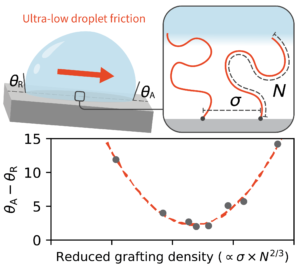
Visualizing Nanoscale Lubricant Layer Under Blood Flow
ACS Applied Materials & Interfaces, 2023
J.K Hong, I.J. Gresham, D. Daniel, A. Waterhouse, C. Neto
Biomedical devices are prone to blood clot formation (thrombosis), and lubricant-infused surfaces (LIS) effectively reduce the thrombotic response. However, the thickness and distribution of the infused lubricant is unknown. In this work, the lubricant thickness is spatially mapped and quantified in situ through confocal dual-wavelength reflection interference contrast microscopy. TLP coatings prepared on glass substrates are exposed to the flow of 37% glycerol/water mixtures (v/v) or whole blood at a shear strain rate of around 2900 s-1 to mimic physiological conditions (similar to flow conditions found in coronary arteries). Excess lubricant (>2 μm film thickness) is removed upon commencement of flow. For untreated glass, the lubricant is completely depleted after 1 minute of shear flow. However, on optimised TLP surfaces, nanoscale films of lubricants (thickness between 100 nm and 2 μm) are retained indefinitely. The nanoscale films conform to the underlying structure of the TP layer and are sufficient to prevent the adhesion of red blood cells and platelets.

Exploring the water capture efficiency of covalently attached liquid-like surfaces
Journal of Chemical Physics, 2023
A. Katselas, I. J. Gresham, A. R. J. Nelson, C. Neto
The capture of moisture from the atmosphere through condensation has the potential to provide a sustainable source of water. Here, we investigate condensation in conditions similar to those of natural dew capture and explore how contact angle and contact angle hysteresis affect water capture rates. We compare water collection on both hydrophilic and hydrophobic slippery covalently attached liquids, as well as on conventional hydrophilic, high-hysteresis substrates.
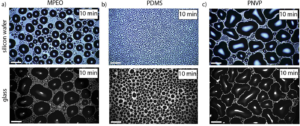
Advances and challenges in slippery covalently-attached liquid surfaces
Adv. Colloid Interface Sci., 2023
I.J Gresham, C. Neto
Over the past decade, a new class of slippery, anti-adhesive surfaces known as slippery covalently-attached liquid surfaces (SCALS) has emerged, characterized by low values of contact angle hysteresis (CAH, less than 5˚) with water and most solvents. Despite their nanoscale thickness (1 to 5 nm), SCALS exhibit behavior similar to lubricant-infused surfaces, including high droplet mobility and the ability to prevent icing, scaling, and fouling. To date, SCALS have primarily been obtained using grafted polydimethylsiloxane (PDMS), though there are also examples of polyethylene oxide (PEO), perfluorinated polyether (PFPE), and short-chain alkane SCALS. Importantly, the precise physico-chemical characteristics that enable ultra-low CAH are unknown, making rational design of these systems impossible.
In this review, the properties of reported SCALS are quantitatively analyzed, revealing trends in the existing data and highlighting areas for future experimental study.
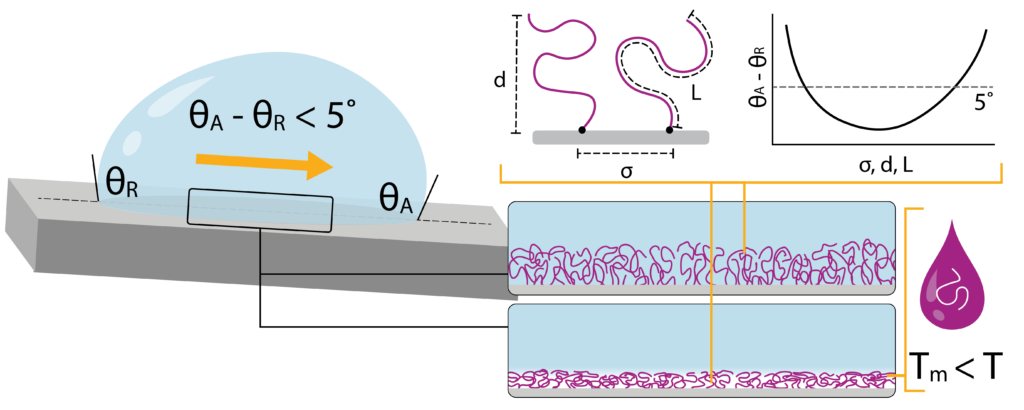
Nanobubbles explain the large slip observed on lubricant-infused surfaces
Nature Communications, 2022
C. Vega-Sánchez, S. Peppou-Chapman, L. Zhu; C. Neto
Lubricant-infused surfaces hold promise to reduce the huge frictional drag that slows down the flow of fluids at microscales. We show that infused Teflon wrinkled surfaces induce an effective slip length 50 times larger than expected based on the presence of the lubricant alone. This effect is particularly striking as it occurs even when the infused lubricant’s viscosity is several times higher than that of the flowing liquid. Crucially, the slip length increases with increasing air content in the water but is much higher than expected even in degassed and plain Milli-Q water. Imaging directly the immersed interface using a mapping technique based on atomic force microscopy meniscus force measurements reveals that the mechanism responsible for this huge slip is the nucleation of surface nanobubbles. Using a numerical model and the height and distribution of these surface nanobubbles, we can quantitatively explain the large fluid slip observed in these surfaces.
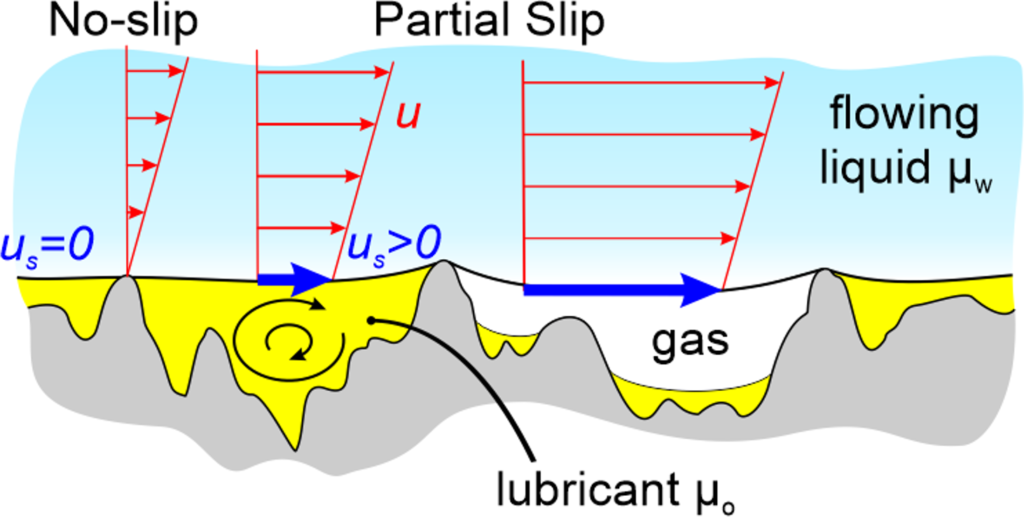
Mechanisms for Reduced Fibrin Clot Formation on Liquid-Infused Surfaces
Adv. Healthcare . Mater., 2022
J.K. Hong, A.M. Ruhoff, K. Mathur, C. Neto, A. Waterhouse
Biomedical devices are prone to blood clot formation (thrombosis), and lubricant-infused surfaces (LIS) are effective in reducing the thrombotic response. However, the mechanisms that underpin this performance, and in particular the role of the lubricant, are not well understood. In this work we investigate whether the mechanism of LIS action is related to i) inhibition of factor XII activation and the contact pathway; ii) reduced fibrin density of clots formed on surfaces; iii) increased mobility of proteins or cells on the surface due to the interfacial flow of the lubricant. The chosen LIS was, covalently tethered, nanostructured layers of perfluorocarbons, infused with thin films of medical-grade perfluorodecalin (tethered-liquid perfluorocarbon), prepared with chemical vapor deposition previously optimized to retain lubricant under flow. Results show that in the absence of external flow, interfacial mobility was inherently higher at the liquid-blood interface, making it a key contributor to the low thrombogenicity of LIS, as factor XII activity and fibrin density were equivalent at the interface. The findings of this study advance our understanding of the anti-thrombotic behavior of LIS-coated biomedical devices for future coating design. More broadly, enhanced interfacial mobility may be an important, underexplored mechanism for the anti-fouling behavior of surface coatings.
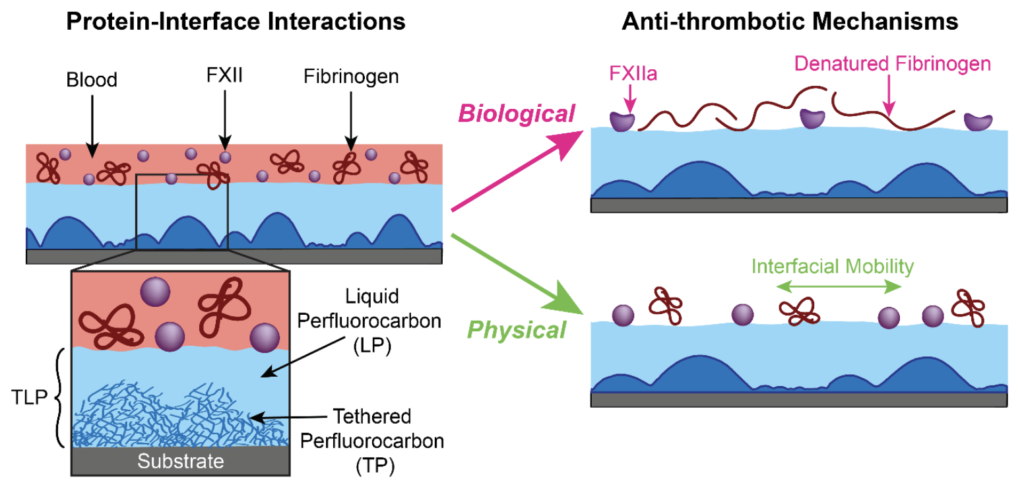
Detection of Nanobubbles on Lubricant-Infused Surfaces Using AFM Meniscus Force Measurements
Langmuir, 2022
S. Peppou-Chapman, C. Vega-Sanchez, C. Neto
So far, the presence of nanobubbles on lubricant-infused surfaces (LIS) has been overlooked, because of the difficulty in detecting them in such a complex system. We recently showed that anomalously large interfacial slip measured on LIS is explained by the presence of nanobubbles [Vega-Sánchez, Peppou-Chapman, Zhu and Neto, Nat. Commun., 202213, 351]. Crucial to drawing this conclusion was the use of atomic force microscopy (AFM) force–distance spectroscopy (meniscus force measurements) to directly image nanobubbles on LIS. This technique provided vital direct evidence of the spontaneous nucleation of nanobubbles on lubricant-infused hydrophobic surfaces. In this paper, we describe in detail the data collection and analysis of AFM meniscus force measurements on LIS and show how these powerful measurements can quantify both the thickness and distribution of multiple coexisting fluid layers (i.e., gas and oil) over a nanostructured surface. Using this technique, thousands of force curves were automatically analyzed. The results show that the interfacial tension of the nanobubbles is reduced from 52 ± 9 mN m–1 to 39 ± 4 mN m–1 by the presence of the silicone oil layer.
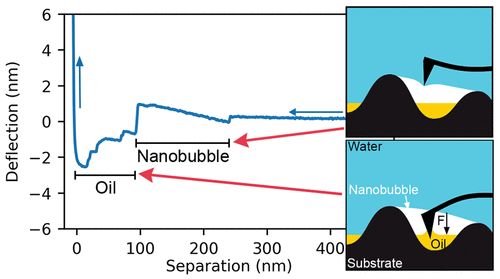
Slightly Depleted Lubricant-infused Surfaces Are No Longer Slippery
Langmuir, 2022
C. Vega-Sánchez, C. Neto
Textured surfaces infused with a lubricating fluid effectively reduce fouling and drag. These functions critically depend on the presence and distribution of the lubricant, which can be depleted by many mechanisms, including shear flow. We present a two-phase Couette flow computational dynamic simulation over lubricant-infused surfaces containing grooves oriented perpendicular to the flow direction, with the aim of revealing how interfacial slip, and therefore drag reduction, is impacted by lubricant depletion. We show that even a slight (20%) lubricant loss decreases slip to the point of making the lubricant superfluous, even for lubricants with lower viscosity than the flowing liquid and regardless of how well the lubricant wets the grooves. We explain that the drastic slip reduction is linked to a significant increase in the total viscous dissipation and to zero dissipation in the lubricant (similar to the one given by a no-slip boundary).
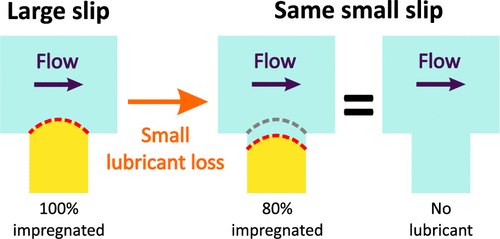
By year
2024
- C. Vega-Sanchez, C. Neto*; “Fluid slip and drag reduction on liquid-infused surfaces under high static pressure” Langmuir (2024) 10.1021/acs.langmuir.3c03792 (IF = 4.33)
- G. Turpin, D. Nguyen, P. Subramanian, T. Davey, S. F. Cheong, Greg Warr, C. Neto*, Brian Hawkett “Tensile benefits of nanofibers in commercial paint” Polym. Chem. (2024) 10.1039/d3py01335a. (IF = 4.760)
2023
- I.J. Gresham, S. G. Lilley, A. R. J. Nelson, K. Koynov, C. Neto; “Nanostructure Explains the Behavior of Slippery Covalently Attached Liquid Surfaces” Angewandte Chemie (2023) 10.1002/anie.202308008 (IF=16.6) Journal open access
- I.J. Gresham, C. Neto; “Advances and challenges in slippery covalently-attached liquid surfaces” Adv. Colloid Interface Sci. (2023) 10.1016/j.cis.2023.102906 (IF=15.2)
- A. Katselas, I. J. Gresham, A. R. J. Nelson, C. Neto; “Exploring the water capture efficiency of covalently attached liquid-like surfaces” J. Chem. Phys. (2023) 10.1063/5.0146847 (IF=4.3)
- J.K. Hong, I. J. Gresham, D. Daniel, A. Waterhouse, C. Neto; “Visualizing Nanoscale Lubricant Layer Under Blood Flow” ACS Appl. Mater. Interfaces (2023) 10.1021/acsami.3c11898 (IF=9.5)
- D. Stuart-Fox, L. Ng, L. Barner, A.T.D. Bennet, S. J Blamires, M. A. Elgar, A. R. Evans, A. Franklin, K. Hölttä-Otto, J. A Hutchison, F. Jativa, A. Jessop, J. Kelley, J. McGaw, J. Mei, M. Mirkhalaf, M. Musameh, C. Neto, A. J. O’Connor, T. Schork, G. E Schröder-Turk, N. H Voelcker, A. Wang, G. S Watson, J. A Watson, L. Wesemann, W. WH Wong; “Challenges and opportunities for innovation in bioinformed sustainable materials”; Commun. Mater. 4, 80 (2023) https://rdcu.be/dnJI9 (IF = 7.8) Journal open access
- G. McHale, R. Ledesma-Aguilara, C. Neto; “Cassie’s Law Reformulated: Composite Surfaces From Superspreading to Superhydrophobic” Langmuir 39, 11028-11035 (2023) doi:10.1021/acs.langmuir.3c01313 (IF = 4.33) Journal open access
2022
- J.K. Hong, A.M. Ruhoff, K. Mathur, C. Neto, A. Waterhouse; “Mechanisms for Reduced Fibrin Clot Formation on Liquid-Infused Surfaces” Adv. Healthcare . Mater. 10.1002/adhm.202201360 (2022)
- C. Vega-Sánchez, C. Neto*; “Slightly Depleted Lubricant-infused Surfaces Are No Longer Slippery”, Langmuir (2022) https://doi.org/10.1021/acs.langmuir.2c01412 (IF = 4.33)
- S. Peppou-Chapman, C. Vega-Sanchez, C. Neto*; “Detection of Nanobubbles on Lubricant-Infused Surfaces Using AFM Meniscus Force Measurements”, Langmuir 10.1021/acs.langmuir.2c01411 (2022).(IF = 4.33)
- A. Katselas, R. Parin, C. Neto*; “Quantification of Nucleation Site Density as a Function of Surface Wettability on Smooth Surfaces” Adv. Mater. Interfaces 9, 2200246 (2022) (IF = 6.14) Journal open access
- Vega-Sánchez, C; Peppou-Chapman, S; Zhu, L; Neto, C*; “Nanobubbles explain the large slip observed on lubricant-infused surfaces” Nature Comm.. 13, 351 (2022). DOI:10.1038/s41467-022-28016-1 (IF=17.7) Highlighted by the Editor, 26 Jan 2022.
- Hong, J. K; Mathur, K; Ruhoff, A. M; Akhavan, B; Waterhouse, A; Neto, C; “Design Optimization of Perfluorinated Liquid-Infused Surfaces for Blood-Contacting Applications” Adv. Mater. Interfaces, 2022, 2102214. (IF = 6.14) DOI:10.1002/admi.202102214
2021
- Vega-Sánchez, C; Neto, C; “Pressure Drop Measurements in Microfluidic Devices: A Review on the Accurate Quantification of Interfacial Slip”, Adv. Mater. Interfaces, 2101641, 2021. (IF = 6.14) with cover DOI:10.1002/admi.202101641
- Baeckens, S; Temmerman, M; Gorb S.N; Neto, C; Whiting, M.J; Van Damme, R; “Convergent evolution of skin surface microarchitecture and increased skin hydrophobicity in semi-aquatic anole lizards”. J Exp Biol. 224, 2021, DOI:10.1021/acs.langmuir.0c02858 (IF = 3.312)
- Peppou-Chapman, S and Neto, C. Depletion of the lubricant from lubricant-infused surfaces due to an air/water interface Langmuir (2021). 10.1021/acs.langmuir.0c02858 (IF = 4.33)
- Fenati, R.A; Quinn, M.S; Bilinsky, H.C; and Neto, C. Antifouling Properties of Liquid-Infused Riblets Fabricated by Direct Contactless Microfabrication Advanced Engineering Materials (2021) 10.1002/adem.202000905, open access link
- Wang, Z; Owais, A; Neto, C; Pereira, J.M; and Gan, Y. Enhancing Spontaneous Droplet Motion on Structured Surfaces with Tailored Wedge Design Advanced Materials Interfaces, (2021) 10.1002/admi.202000520, open access link
- Djerdjev, AM; Priyananda, P; Gore, J; Beattie, JK; Neto, C; and Hawkett, BS. Safer Emulsion Explosives Resulting from NOx Inhibition Chemical Engineering Journal (2021) 10.1016/j.cej.2020.125713, open access link
2020
- Hong, JK; Gao, L; Singh, J; Goh, T; Ruhoff, AM; Neto, C and Waterhouse A. Evaluating medical device and material thrombosis under flow: current and emerging technologies Biomaterials Science, 8, (21), 5824-5845, 2020. DOI: 10.1039/d0bm01284j, open access link
- Nguyen, D; Zhu, L; Huynh, VT; Azniwati, A; Pham, N; Lam, M; Serelis, AK; Davey, T; Such, C; Neto, C and Hawkett. BS. Soft-hard Janus nanoparticles for polymer encapsulation of solid particulate Polymer Chemistry, 11, (35), 5610-5618, 2020. DOI: 10.1039/d0py00845a, open access link
- Peppou-Chapman, S; Hong, JK; Waterhouse, A and Neto, C. Life and death of liquid-infused surfaces: A review on the choice, analysis and fate of the infused liquid layer Chemical Society Reviews, 49, (11), 3688-3715, 2020. DOI: 10.1039/d0cs00036a, open access link
- Scarratt, LRJ; Zhu, L and Neto, C. Large Effective Slip on Lubricated Surfaces Measured with Colloidal Probe AFM. Langmuir, 36, (21), 6033-6040, 2020. DOI: 10.1021/acs.langmuir.9b02935, open access link
2019
- O’Reilly, C; Motion, A; and Neto, C. Looking Thru the Nano Lens: Art, Science and Nature. International Journal of Innovation in Science and Mathematics Education, 27, (7), 23-33, 2019. DOI: 10.30722/IJISME.27.07.003, open access link
- Katselas, A; Motion, A; O’Reilly, C and Neto, C. Chemical Curiosity on Campus: An Undergraduate Project on the Structure and Wettability of Natural Surfaces. Journal of Chemical Education, 96, (9), 1998-2002, 2019. DOI: 10.1021/acs.jchemed.9b00324
- Owais, A; Djerdjev, AM; Hook, JM; Yuen, A; Rowlands, W; White, NG and Neto, C. Host-guest interactions of catechol and 4-ethylcatechol with surface-immobilized blue-box molecules. Journal of Materials Chemistry A, 7, (20), 12713-12722, 2019. DOI: 10.1039/c9ta00556k
- Scarratt, LRJ; Zhu, L and Neto, C. How slippery are SLIPS? Measuring effective slip on lubricated surfaces with colloidal probe atomic force microscopy. Langmuir, 35 (8), 2976-2982, 2019. DOI: 10.1021/acs.langmuir.8b03767, open access link
- Colusso, E; Martucci, A and Neto, C. Fabrication of biomimetic micropatterned surfaces by sol-gel dewetting. Advanced Materials Interfaces, 6 (4), 1801629, 2019. DOI: 10.1002/admi.201801629
- Tonelli, M; Peppou-Chapman, S; Ridi, F and Neto, C. Effect of pore size, lubricant viscosity, and distribution on the slippery properties of infused cement surfaces. The Journal of Physical Chemistry C, 123 (5), 2987-2995, 2019. DOI: 10.1021/acs.jpcc.8b11221
- Shou, K; Hong, JK; Wood, ES; Hook, JM; Nelson, A; Yin, Y; Andersson, GG; Abate, A; Steiner, U and Neto, C. Ultralow surface energy self-assembled monolayers of iodo-perfluorinated alkanes on silica driven by halogen bonding. Nanoscale, 11 (5), 2401-2411, 2019. DOI: 10.1039/c8nr08195f
- Vullers, F; Peppou-Chapman, S; Kavalenka, MN; Holscher, H and Neto, C. Effect of repeated immersions and contamination on plastron stability in superhydrophobic surfaces. Physics of Fluids, 31 (1), 012102, 2019. DOI: 10.1063/1.5064817
2018
- Peppou-Chapman, S and Neto, C. Mapping depletion of lubricant films on antibiofouling wrinkled slippery surfaces. ACS Applied Materials and Interfaces, 10 (39), 33669-33677, 2018. DOI: 10.1021/acsami.8b11768
- Owais, A; Smith-Palmer, T; Gentle, A and Neto, C. Influence of long-range forces and capillarity on the function of underwater superoleophobic wrinkled surfaces. Soft Matter, 14 (32), 6627-6634, 2018. DOI: 10.1039/c8sm00709h
- Chiu, M; Wood, JA; Widmer-Cooper, A and Neto, C. Aligned droplet patterns by dewetting of polymer bilayers. Macromolecules, 51 (15), 5485-5493, 2018. DOI: 10.1021/acs.macromol.8b00620
- Ware, CS; Smith-Palmer, T; Peppou-Chapman, S; Scarratt, LRJ; Humphries, EM; Balzer, D and Neto, C. Marine antifouling behavior of lubricant-infused nanowrinkled polymeric surfaces. ACS Applied Materials & Interfaces, 10 (4), 4173-4182, 2018. DOI: 10.1021/acsami.7b14736, open access link
- Djerdjev, AM; Priyananda, P; Gore, J; Beattie, JK; Neto, C and Hawkett, BS. The mechanism of the spontaneous detonation of ammonium nitrate in reactive grounds. Journal of Environmental Chemical Engineering, 6 (10), 281-288, 2018. DOI: 10.1016/j.jece.2017.12.003
2017
- Gao, N; Chiu, M and Neto, C. Receding contact line motion on nanopatterned and micropatterned polymer surfaces. Langmuir, 33 (44), 12602-12608, 2017. DOI: 10.1021/acs.langmuir.7b03100
- Zhu, L; Nguyen, D; Davey, T; Baker, M; Such, C; Hawkett, BS and Neto, C. Mechanical properties of Ropaque hollow nanoparticles. Polymer, 131, 10-16, 2017. DOI: 10.1016/j.polymer.2017.10.030
- Telford, AM; Thickett, SC and Neto, C. Functional patterned coatings by thin polymer film dewetting. Journal of Colloid and Interface Science, 507, 453-469, 2017. DOI: 10.1016/j.jcis.2017.07.004
- Scarratt, LRJ; Steiner, U and Neto, C. A review on the mechanical and thermodynamic robustness of superhydrophobic surfaces. Advances in Colloid and Interface Science, 246, 133-152, 2017. DOI: 10.1016/j.cis.2017.05.018
- Al-Khayat, O; Hong, JK; Beck, DM; Minett, AI and Neto, C. Patterned polymer coatings increase the efficiency of dew harvesting. ACS Applied Materials and Interfaces, 9 (15), 13676-13684, 2016. DOI: 10.1021/acsami.6b16248
2016
- Al-Khayat, O; Hong, JK; Geraghty, K and Neto, C. “The good, the bad, and the slippery”: A tale of three solvents in polymer film dewetting. Macromolecules, 49 (17), 6590-6598, 2016. DOI: 10.1021/acs.macromol.6b01579
- Rowe, M; Teo, GH; Horne, J; Al-Khayat, O; Neto, C and Thickett, SC. High glass transition temperature fluoropolymers for hydrophobic surface coatings via RAFT copolymerization. Australian Journal of Chemistry, 69 (7), 725-734, 2016. DOI: 10.1071/CH15787
- Scarratt, LRJ; Hoatson, BS; Wood, ES; Hawkett, BS and Neto, C. Durable superhydrophobic surfaces via spontaneous wrinkling of Teflon AF. ACS Applied Materials & Interfaces, 8 (10), 6743-6750, 2016. DOI: 10.1021/acsami.5b12165
- Telford, AM; Easton, CD; Hawkett, BS and Neto, C. Waterborne, all-polymeric, colloidal ‘raspberry’ particles with controllable hydrophobicity and water droplet adhesion properties. Thin Solid Films, 603, 69-74, 2016. DOI: 10.1016/j.tsf.2016.01.052
- Al-Khayat, O; Geraghty, K; Shou, K; Nelson, A and Neto, C. Chain collapse and interfacial slip ofpolystyrene films in good/nonsolvent vapor mixtures. Macromolecules, 49 (4), 1344-1352. DOI: 10.1021/acs.macromol.5b02253
- Charrault, E; Lee, T; Easton, CD and Neto, C. Boundary flow on end-grafted PEG brushes. Soft Matter, 12 (6), 1906-1914. DOI: 10.1039/c5sm02546j
2015
- Wong, I; Teo, GH; Neto, C and Thickett, SC. Micropatterned surfaces for atmospheric water condensation via controlled radical polymerization and thin film dewetting. ACS Applied Materials and Interfaces, 7 (38), 21562-21570, 2015. DOI: 10.1021/acsami.5b06856
- Ghezzi, M; Wang, P-Y; Kingshott, P and Neto, C. Guiding the dewetting of thin polymer films by colloidal imprinting. Advanced Materials Interfaces, 2 (11), 1500068, 2015. DOI: 10.1002/admi.201500068
- Lee, T; Hendy, SC and Neto, C. Control of nanoparticle formation using the constrained dewetting of polymer brushes. Nanoscale, 7 (7), 2894-2899, 2015. DOI: 10.1039/c4nr07412b
- Priyananda, P; Djerdjev, AM; Gore, J; Neto, C; Beattie, JK and Hawkett, BS. Premature detonation of an NH4NO3 emulsion in reactive ground. Journal of Hazardous Materials, 283, 314-320, 2015. DOI: 10.1016/j.jhazmat.2014.08.070
2014
- Ghezzi, M; Thickett, SC; Telford, AM; Easton, CD; Meagher, L and Neto, C. Protein micropattersn by PEG grafting on dewetted PLGA films. Langmuir, 30 (39), 11714-11722, 2014. DOI: 10.1021/la5018592
- Lee, T; Charrault, E and Neto, C. Interfacial slip on rough, patterned and soft surfaces: A review of experiments and simulations. Adv. Colloid Interface Sci., 210, 21-38, 2014. DOI: 10.1016/j.cis.2014.02.015
2013
- Telford, AM; Neto, C and Meagher, L. Robust grafting of PEG-methacrylate brushes from polymeric coatings. Polymer, 54 (21), 5490-5498, 2013. DOI: 10.1016/j.polymer.2013.07.077
- Telford, AM; Hawkett, BS; Such, C and Neto, C. Mimicking the wettability of the rose petal using self-assembly of waterborne polymer particles. Chemistry of Materials, 25 (17), 3472-3479, 2013. DOI: 10.1021/cm4016386
- Telford, AM; Pham, BTT; Neto, C and Hawkett, BS. Micron-sized polymstyrene particles by surfactant-free emulsion polymerization in air: Synthesis and mechanism. Journal of Polymer Science, Part A: Polymer Chemistry, 51 (19), 3997-4002, 2013. DOI: 10.1002/pola.26841
- Lee, T; Hendy, SC and Neto, C. Tunable nanopatterns via the constrained dewetting of polymer brushes. Macromolecules, 46 (15), 6326-6335, 2013. DOI: 10.1021/ma400593z
- Lim, SK; Perrier, S and Neto, C. Patterned chemisorption of proteins by thin polymer film dewetting. Soft Matter, 9 (9), 2598-2602, 2013. DOI: 10.1039/c3sm27241a
2012
- Thickett, SC; Moses, J; Gamble, JR and Neto, C. Micropatterned substrates made by polymer bilayer dewetting and collagen nanoscle assembly support endothelial cell adhesion. Soft Matter, 8 (39), 9996-10007, 2012. DOI: 10.1039/c2sm26557e
- Telford, AM; Meagher, L; Glattauer, V; Gengenbach, TR; Easton, CD and Neto, C. Micropatterning of polymer brushes: Grafting from dewetting polymer films for biological applications. Biomacromolecules, 13 (9), 2989-2996, 2012. DOI: 10.1021/bm3010534
- Lee, T; Hendy, SC and Neto, C. Interfacial flow of simple liquids on polymer brushes: Effect of solvent quality and grafting density. Macromolecules, 45 (15), 6241-6252, 2012. DOI: 10.1021/ma300880y
- Ghezzi, M; Thickett, SC and Neto, C. Early and intermediate stages of guided dewetting in polystyrene thin films. Langmuir, 28 (27), 10147-10151, 2012. DOI: 10.1021/la301773h
- Zhu, L; Attard, P and Neto, C. Reconciling slip measurements in symmetric and asymmetric systems. Langmuir, 28 (20), 7768-7774, 2012. DOI: 10.1021/la301040d
- Zhu, L; Neto, C and Attard, P. Reliable measurements of interfacial slip by colloid probe atomic force microscopy. III. Shear-rate-dependent slip. Langmuir, 28 (7), 3465-3473, 2012. DOI: 10.1021/la204566h
2011
- Telford, AM; Thickett, SC; James, M and Neto, C. Competition between dewetting and cross-linking in poly(N-vinylpyrrolidone)/polystyrene biolayer films. Langmuir, 27 (23), 14207-14217, 2011. DOI: 10.1021/la2029577
- Thickett, SC; Neto, C and Harris, AT. Biomimetic surface coatings for atmospheric water capture prepared by dewetting of polymer films. Advanced Materials, 23 (32), 3718-3722, 2011. DOI: 10.1002/adma.201100290
- Zhu, L; Attard, P and Neto, C. Reliable measurements of interfacial slip by colloid probe atomic force microscopy. I. Mathematical modeling. Langmuir, 27 (11), 6701-6711, 2011. DOI: 10.1021/la2007809
- Zhu, L; Attard, P and Neto, C. Reliable measurements of interfacial slip by colloid probe atomic force microscopy. II. Hydrodynamic force measurements. Langmuir, 27 (11), 6712-6719, 2011. DOI: 10.1021/la104597d
2010
- Willmott, GR; Neto, C and Hendy, SC. Uptake of water droplets by non-wetting capillaries. Soft Matter, 7 (6), 2165-3024, 2011. DOI: 10.1039/c0sm00574f
- Thickett, SC; Harris, A and Neto, C. Interplay between dewetting and layer inversion in poly(4-vinylpyridine)/polystyrene bilayers. Langmuir, 26 (20), 15989-15999, 2010. DOI: 10.1021/la103078k
- Telford, AM; James, M; Meagher, L and Neto, C. Thermally cross-linked PNVP films as antifouling coatings for biomedical applications. ACS Applied Materials & Interfaces, 2 (8), 2399-2408, 2010. DOI: 10.1021/am100406j
- Willmott, GR; Neto, C and Hendy, SC. An experimental study of interactions between droplets and a nonwetting microfluidic capillary. Faraday Discussions, 146, 233-245, 2010. DOI: 10.1039/b925588e
- Joseph, KR and Neto, C. On the superhydrophobic properties of crystallized stearic acid. Aust. J. Chem., 63 (3), 525-528, 2010. DOI: 10.1071/CH09292
- Martelli, C; Canning, J; Khoury, T; Skivesen, N; Kristensen, M; Huyang, G; Jensen, P; Neto, C; Sum, TJ; Hovgaard, MB; Gibson, BC and Crossley, MJ. Self-assembled porphyrin microrods and observation of structure-induced iridescence. J. Mater. Chem., 20 (12), 2310-2316, 2010. DOI: 10.1039/b917695k
- Sriprom, W; Neto, C and Perrier, S. Rapid photochromic nanopatterns from block copolymers. [[Soft Matter, 6 (5), 909-914, 2010. DOI; 10.1039/b920133e
2009
- Huyang, G; Canning, J; Gibson, BC; Khoury, T; Sum, TJ; Neto, C and Crossley, MJ. Focused ion beam processing and engineering of devices in self-assembled supramolecular structures. Nanotechnology, 20 (48), 485301 (6pp), 2009. DOI: 10.1088/0957-4484/20/48/485301
- Neto, C; Joseph, KR and Brant, WR. On the superhydrophobic properties of nickel nanocarpets. Phys. Chem. Chem. Phys., 11 (41), 9537-9544, 2009. DOI: 10.1039/b909899b
- Sriprom, W; James, M; Perrier, S and Neto, C. Ordered microphase separation in thin films of PMMA-PBA synthesized by RAFT: Effect of block polydispersity. Macromolecules, 42 (8), 3138-3146, 2009. DOI: 10.1021/ma9004428
- Neto, C; James, M and Telford, AM. On the composition of the top layer of microphase separated thin PS-PEO films. Macromolecules, 42 (13), 4801-4808, 2009. DOI: 10.1021/ma900690e
Book chapters
- Duong, HTT; Nguyen, D; Neto, C and Hawkett, BS. Synthesis and applications of polymeric Janus nanoparticles. Book chapter in: Soft, Hard, and Hybrid Janus Structures. Synthesis, Self-Assembly, and Applications. ISBN: 978-1-78634-314-7. Editors: Zhiqun Lin and Bo Li. Published by World Scientific Publishing Europe Ltd, UK. Chapter 2, pp 31-67, 2018. DOI: 10.1142/9781786343130_0002

